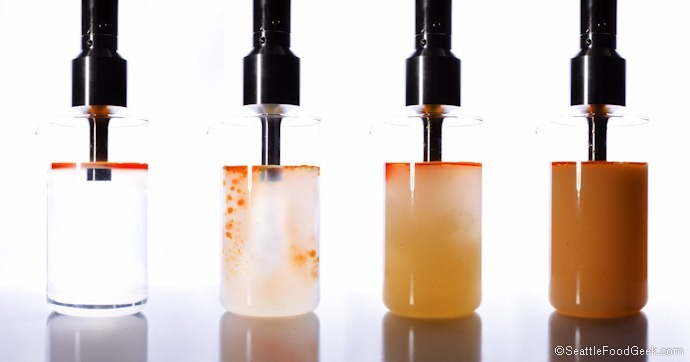
The nice folks at PolyScience generously loaned me a Sonicprep ultrasonic homogenizer for a few weeks of experimentation. If the last sentence sounded like gibberish, it’s probably a good idea to read Jethro’s post on our experiments for a little background knowledge. The Sonicprep is a device that emits powerful ultrasonic energy through the tip of a metal probe, into your food. Fundamentally, high-amplitude ultrasound is really good at two things: making stable emulsions and smashing molecules together. The Sonicprep excels in both applications, but has a few nuances to overcome before I can justify the price for this gorgeous piece of technology. Here I’ll describe some of the tests I preformed with the Sonicprep (many with Jethro’s assistance) and the conclusions we reached.
Making Emulsions
The Sonicprep is really good at emulsifying liquids. Like, scary good. The first thing I did after unboxing the beast of a machine was to pour arbitrary amounts of oil and water into small glasses and give them a whirl in the Sonicprep. Within seconds, the oil and water were mixed into a pale “milk”, and there was almost no trace of the source liquids remaining.
The photo at the top shows a small amount of chili oil being mixed into water. I only let the machine run for a few seconds at full power, which is why you can see the unincorporated oil on the right-hand side. However, if I had continued sonicating, all of the oil would have become incorporated. This isn’t necessarily an oil-to-water ratio I’d recommend; it was mostly to illustrate the process.
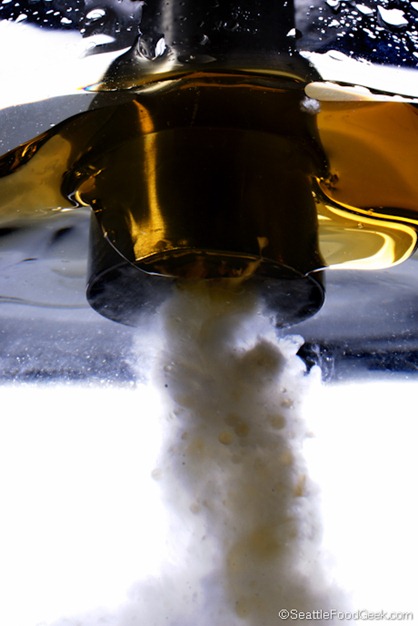 Unfortunately, all of my oil-based emulsions were plagued by a confounding problem: they tasted like metal and smelled like an electrical fire. I’ve talked to several other folks who routinely use ultrasonic homogenizers and nobody else has ever encountered the problem. Chris Young (Modernist Cuisine co-author) suggested that the intense ultrasonic energy may be setting off a chain reaction of free radical release within the oil, but unfortunately I don’t have the equipment necessary to test this theory. It is possible that there was something specific about the machine I was using, or perhaps I was attempting to mix quantities that were just too small… the jury is still out on the cause, but this threw an unfortunate wrench in most emulsion tests.
Unfortunately, all of my oil-based emulsions were plagued by a confounding problem: they tasted like metal and smelled like an electrical fire. I’ve talked to several other folks who routinely use ultrasonic homogenizers and nobody else has ever encountered the problem. Chris Young (Modernist Cuisine co-author) suggested that the intense ultrasonic energy may be setting off a chain reaction of free radical release within the oil, but unfortunately I don’t have the equipment necessary to test this theory. It is possible that there was something specific about the machine I was using, or perhaps I was attempting to mix quantities that were just too small… the jury is still out on the cause, but this threw an unfortunate wrench in most emulsion tests.
I did manage to create some very promising fat-based emulsions. For example, I made the Serious Eats 36-hour Sous Vide Porchetta, which yielded quite a bit of delicious, liquid fat. I sonicated the seasoned fat together with apple and pear cider with a touch of added xanthan gum and it turned into an exquisite gravy with the texture of thickened heavy cream. It was stable over several days and had far more flavor than a comparable dairy-based gravy. WIN!
I also created emulsions with duck fat and used the Sonicprep to emulsify a vegan gelato. It performed wonderfully at those tasks.
The picture to the left shows the tip of the Sonicprep submerged in water with a sesame oil float. The “cloud” emitted from the tip is the turbulent cavitation created by the high-energy ultrasound waves.
Alcohol
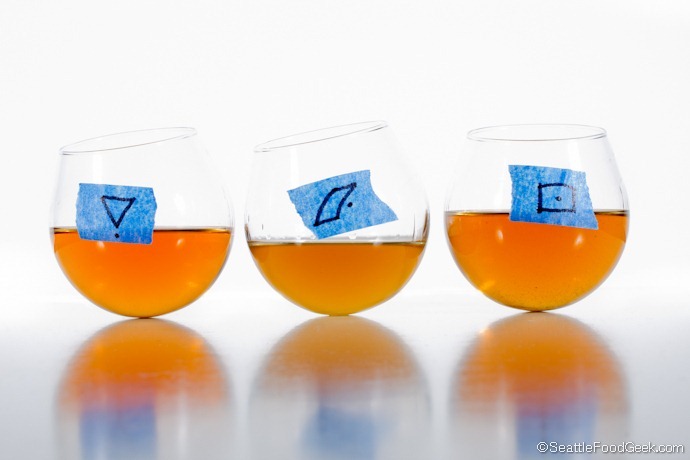
Most of the buzz I’d heard about the Sonicprep was related to its ability to “instant age” spirits. By sonicating alcohol with charred oak chips and other flavorful substances, allegedly one could turn cheap booze into good booze. This promise was tempting, so we ran a few tests. The net-net is that the Sonicprep does seem to improve the quality and “agedness” of spirits through this process.
However, (and this is a big deal) the Sonicprep didn’t produce our favorite faux-aged booze. We set up a double-blind experiment in which we infused whiskey with charred American oak barrel chips and orange peel (rind and pith) using three different infusion methods. We controlled the proportion of wood and orange to whiskey and proceeded to infuse with a) the Sonicprep, b) the Smoking Gun, and c) a whipping siphon with nitrous oxide. I labeled each sample with a letter, then Jethro re-labeled each sample with a symbol (shown above) – that way, neither of us knew which was which. We tasted all three samples and wrote down our tasting notes privately. At the end, we compared our notes and discovered that we reached the same conclusion. The Smoking Gun sample was our least favorite – I attribute this to the fact that orange peel is not meant for burning. I’ve done experiments with Smoking Gun-smoked drinks before, and I’m a fan. The Sonicprep sample came in second – it had a light smokiness and a little burn on the throat. The nitrogen-cavitated sample we infused in the whipping siphon took first place – medium smokiness and a smoother finish. This was a huge shock to both of us.
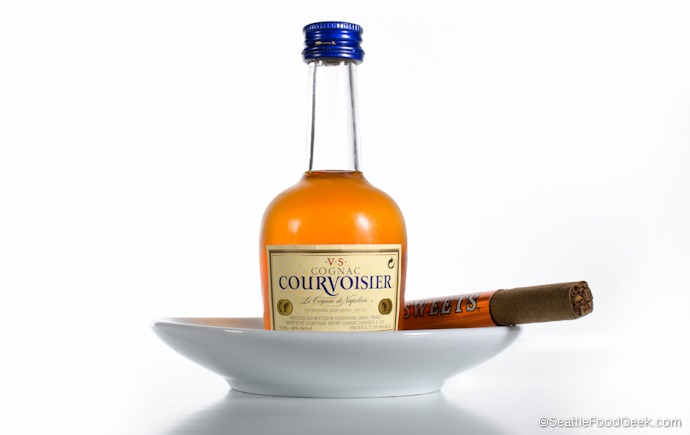
So, we got a little more creative. I had a notion that, if people enjoy smoking cigars while drinking cognac, a cigar-infused cognac might be delicious. Unfortunately, Jethro’s neighborhood bodega didn’t carry actual cigars, so he grabbed a peach flavored Swisher Sweets instead. Ooookkkay, we’re up for anything. In trial one, we unrolled the cigar and sonicated the tobacco in a small bottle of Courvoisier (I know, we’re super classy). This produced a drink that was indistinguishable from the control. So, in trial two, we charred the tobacco and sonicated it into the liquor. This produced a drink with the color of old coffee and the flavor of an ashtray’s butthole. To date, it was the worst thing I’ve ever tasted.
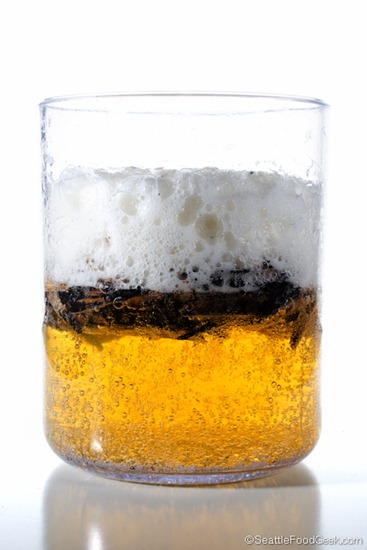
We also tried “barrel aging” beer using the same approach as our liquor trials. The good news is, yes, you can barrel age beer. Even PBR! As you can tell, I’m very selective about my alcohol. Unfortunately, in the process of sonicating the beer, the Sonicprep effectively degassed it. Had we kept CO2 cartriges on-hand, this would have been easy to remedy. Unfortunately, we only had nitrous which doesn’t produce the same acidic flavors. Was barrel aged PBR good? I’m not sure, honestly. Without blind-tasting it, carbonated, at the same temperature as a control, my personal bias creeps in and influences what I think I prefer. But, I believe it has promise.
I also decided to make beer using the Sonicprep. My thinking was this: traditionally, you dissolve the ingredients in a batch of beer by boiling them in water. But, the heat of boiling likely changes the flavor of the beer. If you could dissolve the ingredients and extract flavors without boiling, you’d have a fundamentally different beer. Perhaps it would be the whitest white beer ever! So, I poured a batch of Belgian-style ale ingredients and distilled water into a 5-gallon plastic bucket and started sonicating.
Unfortunately, the effective range of the Sonicprep tip is only a few inches, so it didn’t circulate the beer ingredients as I hoped. The malt extract sank to the bottom and the fuggle floated on the top. Hmph.
Rather than give up (like a sane person might), I divided the 5-gallon batch into 1-liter mini-batches and processed them one-by-one. I added charred oak chips and sonicated the beer on full power for about 5 minutes per batch, then poured the batch through a strainer. Once I had reached the end of 5 gallons (which felt like days later) I added the yeast and let it do its thing. Again, without a control to compare to it’s hard to render an objective judgment, but it’s a good beer. There’s a faint note of charred oak and the beer is light in color, but in no way “white” – the malt extract is quite dark and is responsible for most of the color in the beer. In any event, I got 5 gallons of a very drinkable beer that was never boiled. I’ll call that a WIN.
Coffee
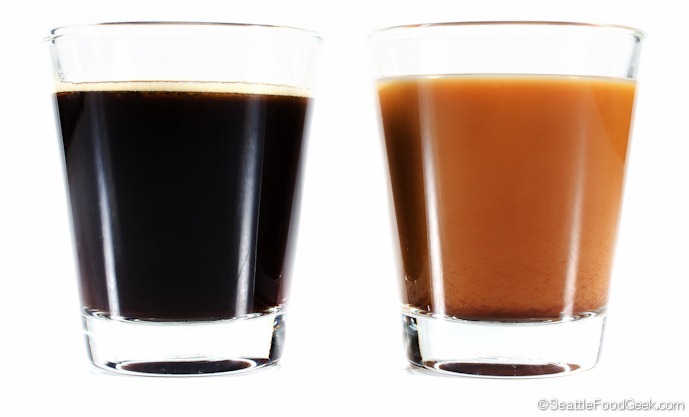
I reasoned that if the Sonicprep could pull flavors from charred oak, it might do interesting things with ground coffee. The photo above shows two shots of espresso – the one on the left was pulled from my Capresso C1000 at full strength; the one on the right was 21g of ground espresso beans sonicated in 200g of water at 76C for 30 seconds at 100% power. Clearly, the two methods produced different results. The Sonicprep espresso has the cloudiness of an emulsion, leading me to hypothesize that some of the oils from the beans were suspended in the water. Strangely, both espressos had the same strength. Due to the different extraction temperatures (the Capresso is closer to 86C), the two samples have unique flavor notes. [I sound like a broken record, but] without a blind taste test, I can’t honestly tell you my preference. However, this result was enough to convince me that the Sonicprep does have the potential for novel applications with coffee.
In Conclusion…
I get really excited every time I hear about a new piece of culinary technology. In this case, as with most of the other tools in my kitchen, the technology itself isn’t new, but it’s application for food and cooking is just being discovered. Ultrasonic machines like the Sonicprep have been used in laboratory sciences as “cell disruptors” and marketed as jewelry cleaners to commercial jewelers. However, they are just beginning to find their place in the kitchen. I admit that I was a little disappointed by some of the limitations of the Sonicprep – low volume processing, the fact that it heats liquids as it processes, my metallic oil issue - but I’m still convinced that there are novel culinary applications for this technology just waiting to be discovered… somebody just has to think them up!
I’m planning to conduct a series of blind taste tests to gather objective data on the Sonicprep results compared to other methods. Playing with the device has also turned on several lightbulbs in my head about the way we approach infusion – I now look at my whipping siphon, vacuum chamber and pressure cooker in a different way than I did before. But, when someone does figure out the truly revolutionary use for high-amplitude ultrasound in the kitchen, we’ll wonder how we ever lived without it.
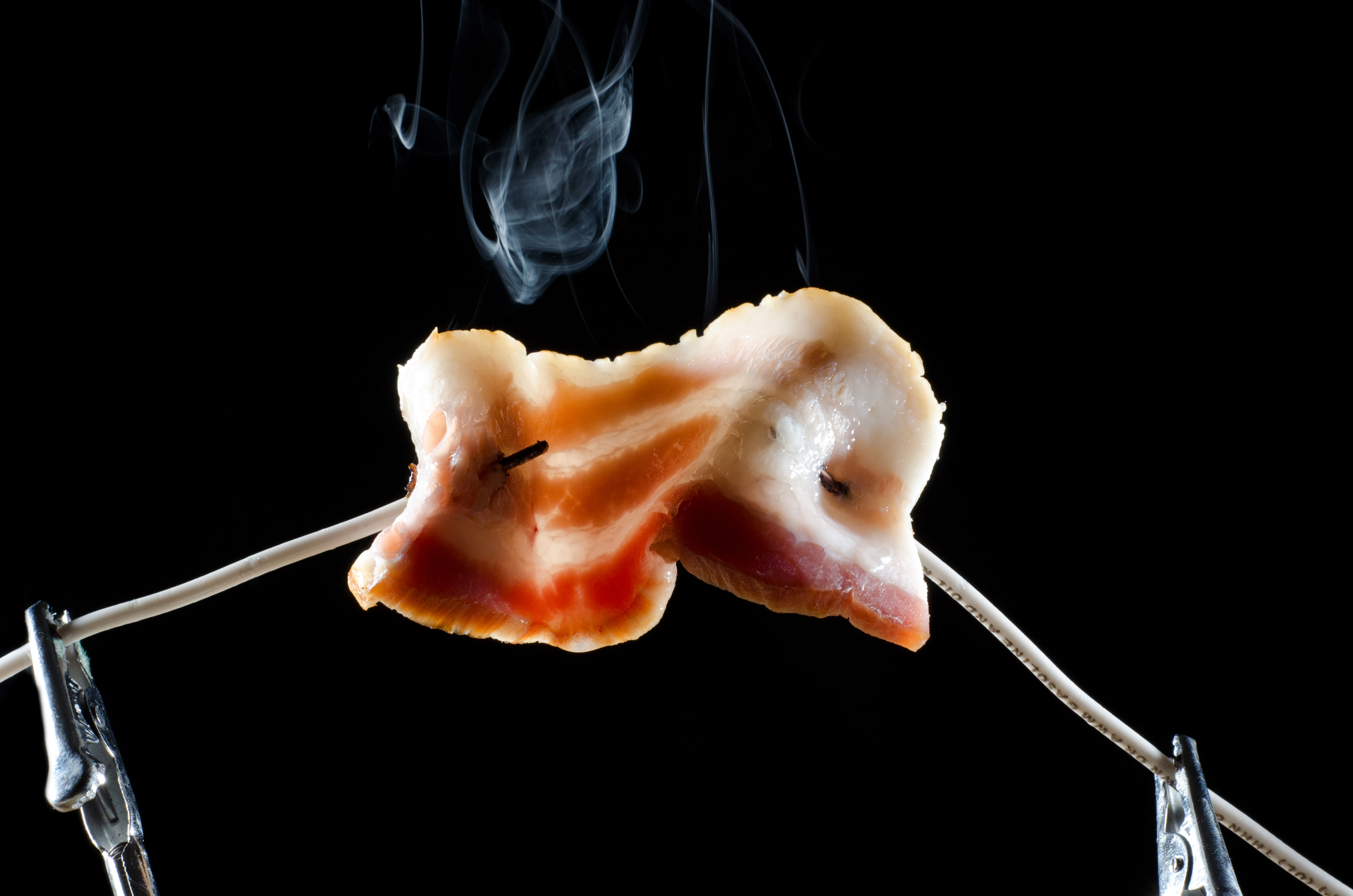
Great post, sounds like you had a lot fun testing.
The obvious question to me is, given the cost of this thing, why not just use a jewelry cleaner? Is this tool that much more powerful, or do you need the more localized effect that it creates?
Hi John, I believe it’s a question of power. The Sonicprep produces up to 400W (in some cases, even more power would have been beneficial).
Have the SonicPrep folks weighed in on the causes of the metallic tastes you observed?
It will be interesting to hear what might have caused that, and see if it can be remedied.
Considering there’s exactly zero chance of purchasing one of these $4500 machines, do you think it would be possible to replicate some of the results by hacking a sonicare toothbrush into a sonic emulsifier?
@Chris believe it or not, I’ve already tried. Unfortunately, no dice. There simply isn’t enough power in a Sonicare to come close to replicating these effects.
You have got a LOT to learn about homebrewing beer.
In homebrewing is it possible that sonication may release more enzymes (invertase) in a shorter period resulting in a faster fermentation.
Pingback: Sonicating Coffee | So Little Time
I was wondering about the possibility of making mayonnaise with something like this. I do like the results I get with the immersion blender, however sometimes it just doesn’t quite work as well as I would like.
Im really curious about the making of espresso as described in the final experiment. Does that mean you are able to take any oily bean or nut, and emulsify the fats with water. Could you for example grind up almonds and make an almond milk with it? 5 years later, hoping ill still get a reply 😛
Yes, but I wouldn’t recommend an ultrasonic homogenizer as the tool of choice for almond milk. It generates considerable heat, which could could contribute to cooked flavors. A rotor stator homogenizer or even just a great blender might be a better tool for that job.
Thanks for the quick reply! The reason im asking is for a project at University. My chosen topic is ultrasound and possible applications for it. Being able to use it for different beverages is very interesting, and im curious if there are possibilities to take the technology and use it for different tasks in a home environment? Do you believe there is a possible market for this and if so point me in a direction where I can find more knowledge on the topic?
Awesome writeup, Scott!
I’m curious what your long-term takeaways have been as you’ve continued using the SonicPrep over the last 5 years. No doubt you’ve found that it lends itself to some things and not others. What’s the sweet spot, and what’s the stuff that are better left to a Vitamix?
Also, how well does it work for highly viscous liquids like mayonnaise or ganache?